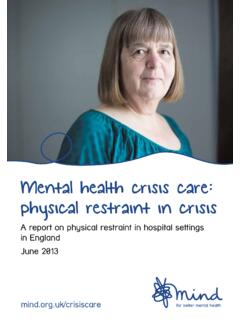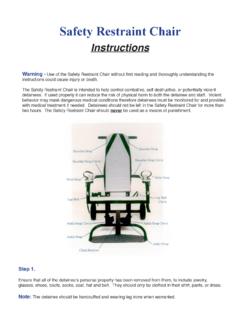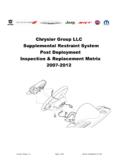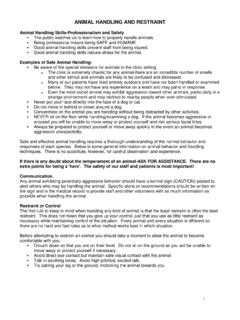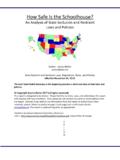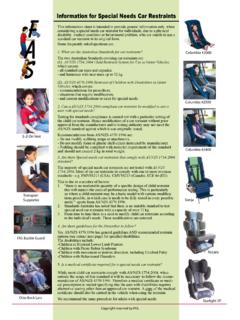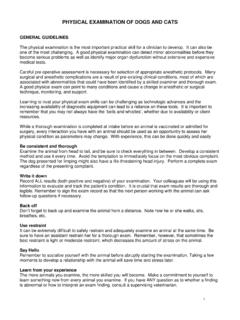Transcription of Restraint and Seclusion PARTICIPANT HANDOUT
1 Collaborative Safety Strategies New Employee Training Program Restraint and Seclusion PARTICIPANT HANDOUT Developed by Office of the Commissioner Division of Safety Services Safety Education and Training Unit July 2013 in collaboration with the New England Healthcare District Bargaining Unit 1199 2 Collaborative Safety Strategies New Employee Training Program All material appearing in this document is in the public domain. However, this publication may not be reproduced or distributed without the specific, written authorization of the Division of Safety Services, Safety Education and Training Unit. Copies of this Handbook in its entirety, may be obtained by contacting Sharon Ciarlo (860) 262-5311 or via email at This Collaborative Safety Strategies (CSS) PARTICIPANT Restraint and Seclusion Handbook is for educational purposes and is designed for use in conjunction with the CSS training program con-ducted by a certified DMHAS, Division of Safety Services, Safety Education and Training Unit CSS Instructor.
2 The content reflects best safety practices for the prevention and management of dan-gerous behavior however, they should not be considered inclusive or exclusive of all the methods of service provision reasonably directed to obtaining the same results. New knowledge, proce-dures, technologies, clinical or research data, and clinical service experiences may provide sound reasons for alternative approaches even though they are not described here. The ultimate judg-ment regarding the use of any specific actions or procedures taken to prevent or manage danger-ous behavior must be made considering the specific individual circumstances presented at the time. State of Connecticut, Department of Mental Health and Addiction Services Division of Safety Services, Safety Education and Training Unit July 2013 Restraint and Seclusion Application for Newly Employed Inpatient Direct Care Staff (CSS-N/RSAT) Upon completion, you will learn be able to: Prevent Restraint and Seclusion related injury or death by clinically assessing the patients mental and physical status during the use of restraints or Seclusion use.
3 Demonstrate the safe application, use of and discontinued use of mechanical restraints or Seclusion according to DMHAS Policy and manufacturer s instructions to prevent use relat-ed physical injury or death. Demonstrate the ability to lift and carry a patient from the floor to a Restraint bed. Use Seclusion according to DMHAS Policy B Recognize when patients have met behavioral criteria to discontinue their use. Successful full completion is demonstrated by : Achieving a score of at least 80% on the written Post-Tests and by, 100% active class participation Accurately demonstrating the ability to apply and remove 4 point leather restraints and for CVH and SW/GB staff, the Net Restraint . Completing the PARTICIPANT Evaluation 3 1 4 Introduction Remember that, DMHAS believes that people have the right to be free the use of Restraint or seclu-sion except to ensure the immediate physical safety of the patient, a staff member, or others.
4 Mechanical restraints are used on our inpatient units at CMHC, CVH , CRMHC and SW/GBCMHC. Seclusion is used at CVH, SW/GB and only on the 4th floor at CMHC. There is also a Seclusion room at CRMHC, but it is rarely used. restraints are defined as Any method, physical or mechanical device, material, or equipment that immobilizes or reduces the ability of a patient to move his or her arms, legs, body, or head freely. Over the past two days, you ve learned a variety of strategies to prevent violence and should it occur, how to use physical restraints to contain it. During this module, when we use the term Restraint , we are referring to 4 point mechanical restraints . Seclusion is defined as The involuntary confinement of a patient alone in a room or an area from which s/he is physically prevented from leaving.
5 Generally, Seclusion is used when containment of the dangerous behavior is required, but when the freedom of movement while in the Seclusion room is safe. Individuals should not be in Seclusion , for example, if they are actively suicidal or self injurious or are unable to contain their physical ag-gression in Seclusion . It s important to know that DMHAS Seclusion and Restraint rates consistently remain below the na-tional average. Still, the use of mechanical restraints and Seclusion are our most high risk interven-tions that can result in injury or death. Preventing R/S related injury or death: Intensive Care for the Patient in R/S The risks of injury and death increase with the use of mechanical restraints and Seclusion . The interventions you ve taken to this point were directed at physically containing the violence.
6 But, that isn t the end of the crisis it s only the point at which the violence is contained. In fact, the interventions that you have to use until the patient is behaviorally safe (out of R/S) are much like an intensive care unit in a medical hospital. That means that immediately prior to, during application and use, you must provide a high level of care to reduce the risk of injury or death: Monitor the patient closely per individualized assessment and R/S Policy constant observation is typical. Whiting has video monitoring on WU6. While monitoring, you must minimally perform the A-F assessment. Remember, that the elderly pose risks associated with poor skin integrity and that their bones tend to be weaker, thus are at greater risks for breaks. Patients who are in restraints are typically on Constant Observation (CO), which means that a staff member is present at all times.
7 Patients in Seclusion , may have the door open with a staff member present (CO) or they may have the door locked, with staff checking at least every 15 minutes. Deci-sions about how closely to monitor are made based on the assessment findings. Continuously reassess physical , medical, emotional and behavioral condition (minimally): Signs of injury associated with R/S use Nutrition and hydration Circulation and ROM Vital Signs Hygiene and elimination physical and psychological status and comfort Patient specific concerns Use your facility specific flow sheets and policy s for other monitoring requirements. 5 2 Communicate concerns immediately to licensed medical staff. Take all complaints of pain, dis-comfort seriously and have it immediately medically evaluated.
8 Never assume that the com-plaint is not serious , attention seeking. Make sure they are fully evaluated by a licensed doctor or nurse. Debrief with the patient about what just happened. Provide reassurance to the patient and in-form them of the specific behavioral criteria for discontinuing R/S. Then work with the patient to discontinue R/S to meet criteria. Your assessment will determine how to help the pt meet the criteria. For example, in an extremely agitated or psychotic patient, some quiet time or music or other calming activity at first will probably be helpful. Find out from the patient, what would help them calm down and regain behavioral self control. Criteria for Release from R/S The main criteria for release from R/S is that the person no longer poses an immediate risk of violence again, think about the scale the risks of remaining in either R/S now would outweigh the risks of release from R or S.
9 Typically, you will observe that: 1. Cognitively, there is a decrease in their focus, hostility and suspicion related to what triggered the behavior. 2. They will be less aroused - irritability and intensity of emotions should be decreased. 3. Behaviorally, impulsivity, verbal aggression, physical aggression, physical tension should be decreased. If they have had medications or used other methods to become calm, you should see fewer or de-creased diagnostic symptoms , psychosis. When you are able to talk with a patient who is in R/S to meet criteria for discontinuing, the focus of the conversation is on the specific criteria. This is not the time for more in-depth, insight gaining dis-cussions. That can and should occur after R/S discontinued.
10 Remember that waiting too long to use R/S can have negative outcomes, so can releasing too early. Make sure that the criteria are met. There s always a risk or reoccurring dangerous behavior, but if the criteria is met and there s a plan in place, the risks should decrease. The ultimate decision to release a patient from R/S must always be made in the consideration of in-dividual circumstances presented by the patient and surrounding circumstances. This information is provided to help focus on the specific clinical data that is needed to make the recommendation to the clinically licensed person responsible for ordering the discontinuation of R/S. After Care of the Person who has been released from R/S Using the intensive care medical model, after a patient has been released from R or S, they should still be monitored closely.










